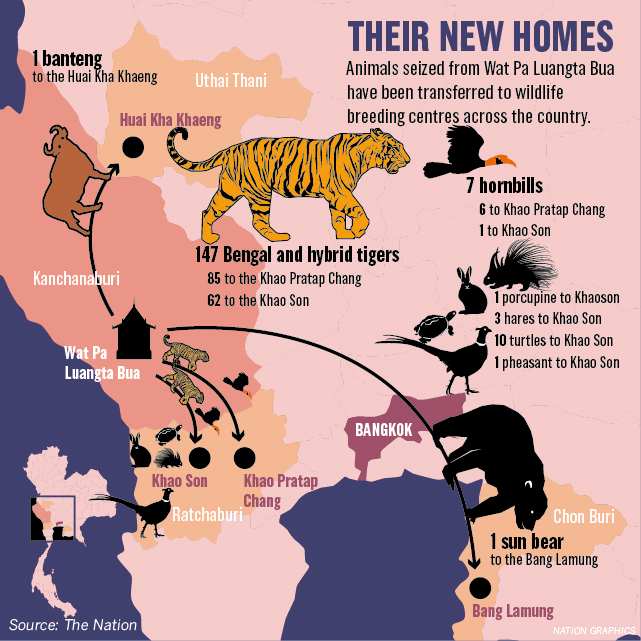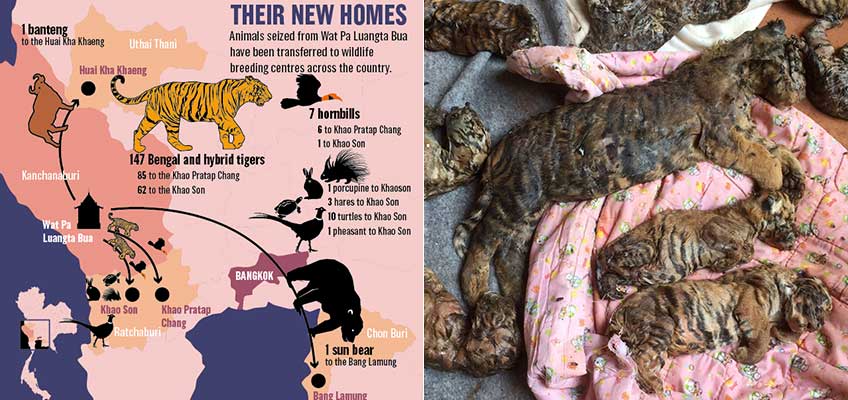Here are answers to interesting questions about the controversial Tiger Temple.
The origins of the Tiger Temple
Wat Pha Luang Ta Bu Yannasampanno was founded in 1994 in Sai Yok district of Kanchanaburi province. It was named after an esteemed monk, Luang Ta Bu Yannasampanno, who was abbot of Wat Ban Tad in Udonthani Province. His teachings were passed down to the present abbot, Luang Ta Chan.
Why is it called the ‘Tiger Temple’?
The temple received its first tiger in 1999, and two years later the number of resident animals increased to eight. As of May 31, shortly before wildlife authorities began a relocation operation at the temple compound, it housed 147 tigers and the cubs of the Bengal and Indochinese species, allegedly bred in the temple.With a number of apparently tame tigers, as well as other animals including Asian bears, hornbills and jackals, the temple became a tourist attraction. It offered up-close and personal contact with the animals, giving visitors the chance to take photos and feed the animals in exchange for payment.
Why has the temple become controversial?
The monks and animal caretakers have long been accused of mistreating animals, as well as illegal breeding and even being involved in wildlife smuggling, as has been allegedly indicated by evidence revealed in the recent relocation operation. A number of tiger cub carcasses were discovered, as well as engraved fangs and other talismans made of animal parts.
How did authorities from the Department of National Parks, Wildlife and Plant Conservation get involved in the issue?
The department confiscated tigers at the temple in 2001 for the first time, but due to sensitivity concerning relocation and immense opposition, it came to an agreement with temple members to leave the tigers under their care. However, the number of tigers at the temple grew to 147 before the latest relocation effort, while the temple could not explain their origins.
The department attempted to relocate tigers twice earlier this year. It managed to relocate 10 to care facilities outside the temple, leaving 137 to be relocated during the latest effort that started on May 31.
In the past year, the issue of international wildlife trafficking came into the spotlight again after wildlife authorities were told three adult tigers had disappeared from the temple. A complaint was filed with the police, which is now under investigation.

Are the tigers registered?
According to the department, they are confiscated items and under the department’s supervision. People possessing tigers – which are protected animals under the 1992 Wildlife Act – without permission could face up to four years in jail or a fine up to Bt40,000, or both. Tigers are also listed in the Convention on International Trade in Endangered Species of Wild Fauna and Flora (Cites) Appendix I, meaning they cannot be traded or exported in any form.
The temple, meanwhile, had only been granted a licence to operate a zoo, not to possess the animals.
Why are the tigers being moved out of the temple this time?
The department has to enforce the law or otherwise it would face Article 157 of the Criminal Code for negligence of duty. It’s also obliged to provide good care for wild animals.
What will happen to the tigers?
The department said the tigers would first be relocated to its two main breeding centres in Ratchaburi. If the tigers prove to be Indochinese, they may be rehabilitated and released in the wild, if strong enough. Bengal tigers cannot be released in the wild. Wildlife widely recognise that tamed animals rarely survive if reintroduced into the wild.






